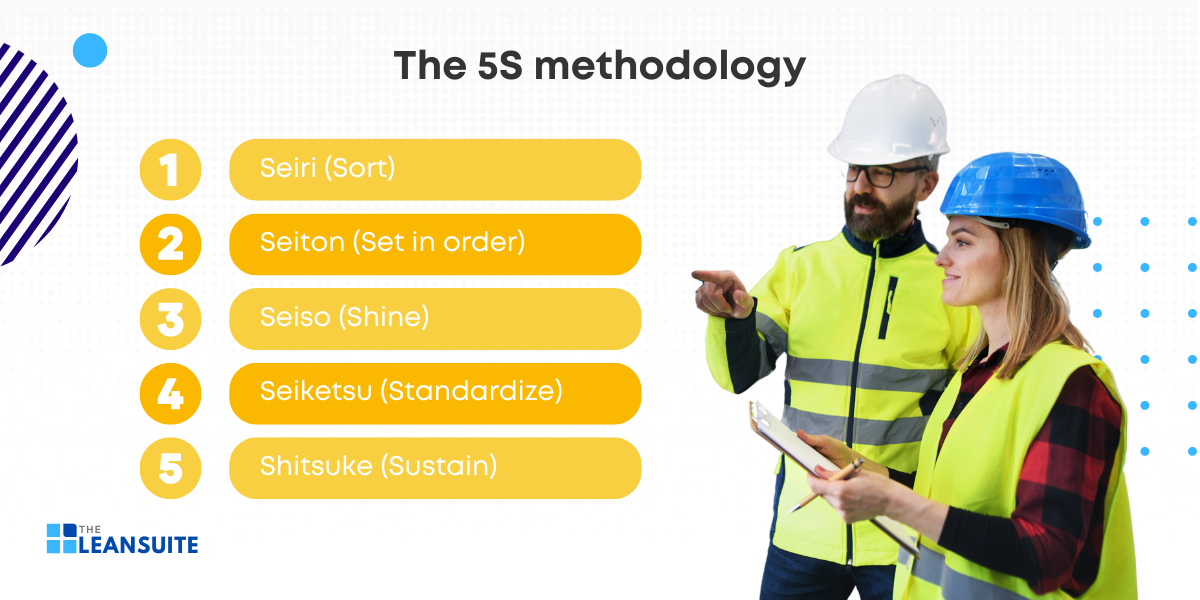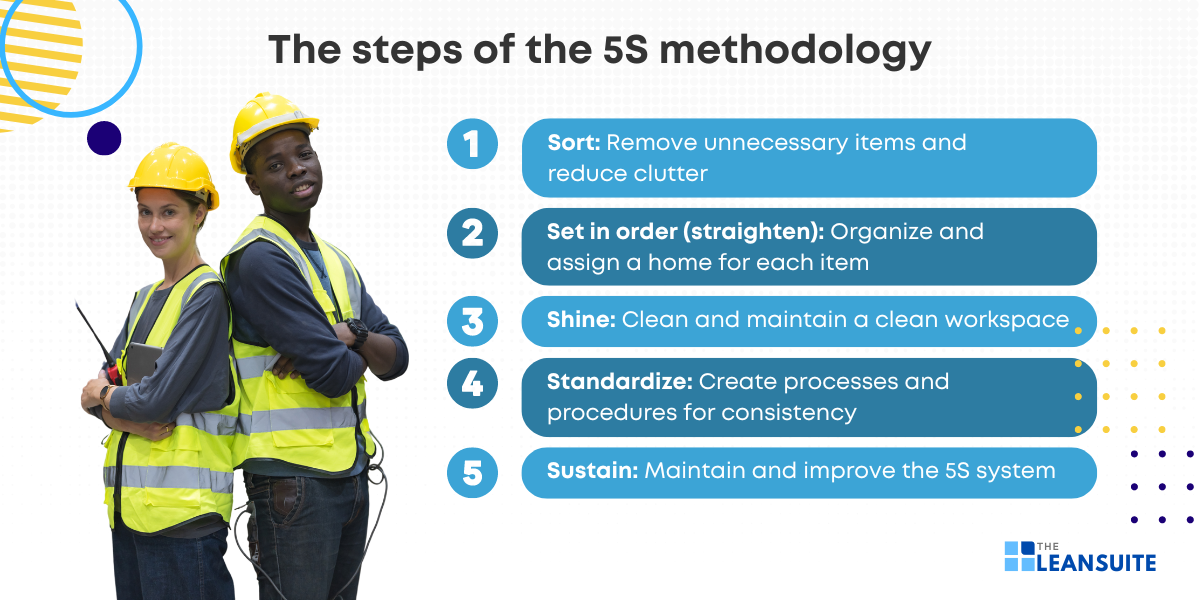Have you ever wondered how some workplaces seem to operate like well-oiled machines? The answer often lies in effective organization, and the 5S methodology can truly transform this aspect. With its five guiding principles—Sort, Set in order, Shine, Standardize, and Sustain—5S empowers individuals and teams to streamline their processes and enhance productivity. In this blog post, we will explore each of these five steps, exploring how they can be applied to any workspace to unlock greater potential and productivity.
Origins of the 5S methodology
The 5S methodology is a fundamental aspect of lean manufacturing with origins that trace back to the Toyota Production System (TPS), which revolutionized industrial efficiency. Essentially, it was developed by Toyota as part of its innovative approach to manufacturing and focuses on streamlining processes by eliminating waste and maximizing value.
This systematic method is grounded in the philosophy of “a place for everything and everything in its place”. That is to say, it promotes organization and efficiency in the workplace. By implementing the 5S methodology, you can achieve greater productivity, safety, and quality. This, in turn, ensures that every tool and resource is optimally utilized and easily accessible. Thus, reducing unnecessary downtime and fostering a culture of continuous improvement.
What is the 5S methodology?

The 5S methodology is a systematic approach aimed at improving workplace organization and efficiency through a series of five steps: Sort, Set in order, Shine, Standardize, and Sustain. This framework originated from Japan and therefore, each of these steps is rooted in a specific Japanese term:
- Seiri (Sort)
- Seiton (Set in order)
- Seiso (Shine)
- Seiketsu (Standardize), and
- Shitsuke (Sustain)
The essence of the 5S methodology is to create a clean, orderly, and well-organized environment that minimizes waste and maximizes productivity. So, by focusing on these principles, you can enhance your operational efficiency and foster a more pleasant workplace atmosphere.
The implementation of the 5S methodology can be characterized as a low-investment, high-impact lean manufacturing tool. One of its most significant advantages is engaging employees directly in managing and improving their workspaces. This involvement not only empowers employees, but also encourages them to take ownership of their environment. Thereby, leading to sustained improvements.
In short, each step of the 5S methodology contributes to reducing clutter, organizing tools and materials, and establishing routine maintenance practices. By adhering to these guidelines, you can achieve a dynamic and well-maintained workspace that supports continuous improvement and operational excellence.
The benefits of implementing the 5S methodology
Eliminate waste and improved efficiency
The 5S methodology aims to boost workplace efficiency and productivity by systematically reducing waste and streamlining processes.
By organizing the workspace, your employees can quickly locate tools and materials. Thus, reducing the time spent searching for items. What’s more, this streamlined environment minimizes interruptions and bottlenecks so it allows for a more fluid workflow.
The practice of regularly sorting and setting in order ensures that only necessary items are kept on hand. This, in turn, prevents clutter and maximizes the efficient use of space and resources.
A safer workplace
By implementing the 5S principles and fostering an environment of clear visual communication, you can create a safer workplace for your employees. In other words, by integrating visual management tools such as signs, labels, and shadow boards, the 5S methodology ensures that important information is readily accessible and easily understood by all employees.
These tools serve as constant reminders of workplace protocols, potential hazards, and necessary safety measures. As a result, this effectively reduces the likelihood of accidents and injuries. By maintaining an organized and visually transparent workspace, the 5S methodology streamlines operations and cultivates a culture of safety awareness. Ultimately, leading to improved overall workplace safety.
Improved morale and employee engagement
Another benefit of implementing the 5S methodology is that it can lead to improved morale and higher levels of employee engagement.
By involving your employees in the organization and maintenance of their workspaces, they feel a greater sense of ownership and responsibility. Consequently, this participatory approach empowers them to contribute to continuous improvement initiatives. Thereby, fostering a collaborative and supportive work culture.
As your employees see tangible improvements in their work environment, they are more likely to feel valued and motivated, which can lead to increased job satisfaction and reduced turnover.
Enhanced quality control
The 5S methodology also contributes to improved quality control within your organization. By standardizing processes and maintaining orderly workspaces, the likelihood of errors, defects, and inconsistencies is reduced. In essence, the disciplined approach of regularly reviewing and refining processes through the 5S framework ensures that quality standards are consistently met.
Moreover, by eliminating unnecessary distractions and focusing on precision, your employees can concentrate better on their tasks and produce higher-quality outputs. This emphasis on quality assurance boosts customer satisfaction and also strengthens your organization’s reputation in the market.
Scale your operations
The 5S methodology offers a significant advantage by allowing your organization to scale their enterprise operations through customizable solutions.
At its core, the 5S methodology is designed to be adaptable. So, this makes it an ideal tool for organizations of all sizes and industries. This flexibility means that you can tailor the 5S practices to address your unique operational challenges and goals. Moreover, when integrated with other lean tools, 5S becomes a powerful component of a comprehensive strategy to enhance manufacturing processes and minimize waste.
By effectively implementing the 5S methodology, you can streamline your operations and position yourself to expand and compete more robustly in the marketplace.
The steps of the 5S methodology

1. Sort: Remove unnecessary items and reduce clutter
The first step in the 5S methodology is to sort, which involves examining the workplace and removing items that are not necessary. Basically, the aim is to declutter the environment so that it’s easier to manage and navigate.
By eliminating what is not needed, your teams can focus on essential tasks without distractions. This process not only reduces waste, but also enhances efficiency by ensuring that only relevant tools and materials are at hand. As a result, this streamlines your operations and facilitates a smoother workflow.
2. Set in order (straighten): Organize and assign a home for each item
Following the sorting stage, the next step is to set in order. This step involves organizing the workspace so that each item has a designated place.
The goal here is to create a logical layout so that unnecessary movements are minimized and time is saved. In other words, when everything is in its rightful place, your employees can easily find what they need. Thus, enhancing productivity and reducing the likelihood of errors.
In short, the orderliness of step number two, set in order, translates into a more efficient work environment where tasks can be completed more swiftly and effectively.
3. Shine: Clean and maintain a clean workspace
The third step, shine, emphasizes the importance of cleanliness and maintenance. A clean workspace contributes significantly to workplace safety because it reduces the risks of accidents and injuries.
Regular cleaning and upkeep of equipment ensures that they are in good working condition and that any potential hazards are promptly addressed. This commitment to cleanliness not only boosts morale, but also reinforces your organization’s dedication to providing a safe and productive environment. Ultimately, enhancing overall efficiency.
4. Standardize: Create processes and procedures for consistency
Standardizing involves establishing procedures and practices to maintain consistency across the workplace. That is to say, this step ensures that sorting, setting in order, and shining are performed consistently and as a regular practice.
By developing clear guidelines and protocols, you can reduce variability and waste which can help you achieve greater efficiency. In short, standardization fosters an environment where your employees know exactly what is expected. This, in turn, leads to more reliable outcomes and a cohesive approach to daily operations.
5. Sustain: Maintain and improve the 5S system
The final step, sustain, focuses on maintaining the 5S system over time. This involves cultivating a culture of continuous improvement where employees are committed to adhering to the 5S standards.
Sustaining the system requires regular training and audits to ensure ongoing compliance and to identify areas for further enhancement. By embedding the principles of 5S into your organizational culture, you can ensure long-term benefits which can sustain improvements in efficiency and productivity well into the future.
Tips to implement the 5S methodology into your workplace
Tip #1: Create a 5S action plan
To successfully implement the 5S methodology, you should start by developing a comprehensive 5S action plan that clearly sets out goals and objectives. So, this involves laying out specific steps for each of the 5S phases: Sort, Set in order, Shine, Standardize, and Sustain.
Essentially, this action plan will serve as a roadmap that guides your organization through the systematic process of workplace organization and efficiency improvement. By doing so, you can ensure that the 5S principles are applied effectively and consistently.
Tip #2: Build a visual workplace
An essential part of the 5S methodology is the creation of a visual workplace. For instance, this will require the strategic use of signs, labels, and visual aids to convey important information and organize the workspace.
Implementing visual management tools helps employees quickly understand processes, locate tools, and adhere to workplace standards. As a result, this reduces waste and errors. By building a visual workplace, you can enhance communication and improve overall efficiency and productivity. So, this will make it easier for everyone to maintain a high standard of work.
Tip #3: Provide training and encourage participation
For the 5S methodology to be successful, it is important to provide comprehensive training and foster active participation from all of your employees.
The training sessions should cover the principles and benefits of the 5S methodology. This ensures that every team member understands their role in its implementation. What’s more, encouraging participation creates a culture of continuous improvement and empowers employees to contribute ideas and take ownership of their spaces.
By investing in training and promoting involvement, you can create a committed workforce that upholds the 5S standards effectively.
How the 5S methodology supports continuous improvement and Kaizen
The 5S methodology is a powerful organization tool that supports continuous improvement and Kaizen by establishing a structured framework for identifying and eliminating waste within your organization.
Through its five stages—Sort, Set in order, Shine, Standardize, and Sustain—5S encourages your employees to actively participate in recognizing inefficiencies and implementing solutions. This participatory approach empowers individuals at all levels to take ownership of their workspaces and processes. Thereby, fostering a culture of continuous improvement.
By consistently applying the principles of the 5S methodology, you can create an environment where problem-solving becomes a shared responsibility, seamlessly integrating the philosophy of Kaizen. This ongoing commitment to continuous improvement not only boosts operational efficiency, but also fosters a resilient organizational culture that embraces and adapts to change over time.
How the 5S methodology helps identify and address the 8 forms of waste
The 5S methodology is an effective tool for recognizing and tackling the eight types of waste, referred to as “Muda,” in lean process management. By systematically organizing and maintaining the workplace, the 5S methodology helps you uncover and eliminate contributors to inefficiencies. For example, unnecessary motion, excess inventory, and the presence of hazardous materials.
This structured approach streamlines operations and enhances workplace safety by mitigating risks and reducing potential safety hazards. As you implement the 5S methodology, this will help you create a more orderly and efficient environment. Consequently, this results in improved overall productivity and a robust foundation for continuous improvement.
Conclusion
In conclusion, the 5S methodology stands out as a powerful tool for enhancing workplace organization and minimizing waste. By employing this systematic approach, you can create a safer environment that boosts both efficiency and productivity.
The structured framework of the 5S methodology ensures that every aspect of the workspace is optimized. So, this allows teams to focus on what truly matters. As companies strive to sharpen their competitive edge, implementing the 5S methodology becomes an invaluable asset in achieving their objectives and fostering a continuous improvement culture.





